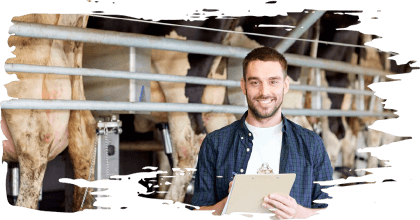Dr. Sabry El-Khodary is a distinguished professor and researcher in the field of veterinary medicine, with an impressive academic and professional trajectory, having completed his education and numerous postdoctoral fellowships across Europe and Japan. He currently serves as the Vice Dean of the College of Veterinary Medicine at Mansoura University, Egypt, where he focuses on internal medicine in ruminants and equines. Dr. El-Khodary has made significant contributions to understanding the impact of mycotoxins on livestock health and productivity, particularly in ruminants.

Dr. El-Khodary, as someone deeply involved in both academic research and practical applications in the field of veterinary medicine, how do you see the current state of integration between scientific research and everyday veterinary practice? Are there areas where you believe there is a significant gap that needs bridging, particularly in the context of mycotoxin management?
Firstly, I would like to express my gratitude to mycotoxinsite for providing me with the chance to discuss the current situation of mycotoxins in ruminant animals.
 Referring to the current state of integration between scientific research and daily veterinary practice, it is variable, depending on the level of scientific research, legislation, and laws related to the management of mycotoxins, as well as the cultural particularities of the different regions.
Referring to the current state of integration between scientific research and daily veterinary practice, it is variable, depending on the level of scientific research, legislation, and laws related to the management of mycotoxins, as well as the cultural particularities of the different regions.
For example, in developed countries such as the United States and European Union countries, there is a clear integration in this field.
However, in my region, the Middle East and similar countries, there is a large gap, especially in the national mycotoxin management.
Despite the existing legislation, the level of scientific research and its practical application towards solving mycotoxin-related problems is largely deficient, and therefore we need greater effort in this aspect.

Among your lines of research, you have explored the impact of mycotoxins on ruminant health. What are some of the most concerning mycotoxins affecting livestock, and what symptoms should farmers look out for in their animals?
Based on my work in the field of ruminant diseases and research on mycotoxins, those that pose the greatest threat are:
- ⇰ Aflatoxins
- ⇰ Ochratoxin
- ⇰ Zearalenone
- ⇰ Fumonisins
The symptoms that farmers should pay attention to in their animals are:
 Severe symptoms, such as diarrhea and sudden deaths.
Severe symptoms, such as diarrhea and sudden deaths. Nonspecific symptoms, such as weight loss, changes in the amount or composition of milk, unexplained lameness, and increased susceptibility of animals to infections and various diseases.
Nonspecific symptoms, such as weight loss, changes in the amount or composition of milk, unexplained lameness, and increased susceptibility of animals to infections and various diseases.


It is often considered that ruminants are more resistant to mycotoxins than other species, however, this is not accurate, is it? Considering your extensive research and fieldwork, are there any surprising findings or misconceptions about mycotoxins, particularly in ruminants, that you think need more attention in the scientific community or public discourse?
There has always been the belief that ruminants are more resistant to mycotoxins than other animals, but this is questionable.
![]() Severe symptoms of mycotoxicosis may not appear in cows in many cases, but the cumulative effect of these toxins over long periods leads to great risks that farm owners may not notice.
Severe symptoms of mycotoxicosis may not appear in cows in many cases, but the cumulative effect of these toxins over long periods leads to great risks that farm owners may not notice.
Additionally, exposure of the animals to mycotoxins can result in their accumulation in animal-derived products, subsequently affecting human health.
 For example, aflatoxins reduce feed intake, alter rumen fermentation, reduce milk production and reproduction, as well as causing damage to the liver, kidneys, and digestive system, and affecting vaccination efficiency, rendering ruminants more susceptible to disease.
For example, aflatoxins reduce feed intake, alter rumen fermentation, reduce milk production and reproduction, as well as causing damage to the liver, kidneys, and digestive system, and affecting vaccination efficiency, rendering ruminants more susceptible to disease.
Given our evolving understanding of the impact that mycotoxins have on livestock, do you believe current legislation and guidelines on acceptable mycotoxin levels in raw materials are sufficient to protect human and animal health?
The World Health Organization (WHO), in collaboration with the Food and Agriculture Organization (FAO), is responsible for assessing the risks of mycotoxins resulting from food contamination to humans and for issuing recommendations on adequate protection.
I believe that current legislation and guidelines regarding acceptable levels of mycotoxins in raw materials are sufficient to protect human and animal health, but the problem lies in strictly implementing these legislations.
Mycotoxins not only pose a risk to human and animal health, but also affect food security and nutrition by reducing people’s access to healthy foods.


In your experience, what role does farmer education and awareness play in managing and mitigating the risks of mycotoxins in livestock feed?
Farmer education and awareness play an important role in managing and mitigating the risks of mycotoxins.
Farmers should regularly check animals’ feed and observe their animals for suspected clinical signs of mycotoxicosis.


Some of your recent studies have highlighted the impact of oxidative stress in dairy cows. How do mycotoxins contribute to oxidative stress, and what are the implications for dairy cow health and productivity?
In ruminants, mycotoxins have been confirmed to induce oxidative stress, hypoxia, and immunosuppression, and emerging evidence shows that they have the potential of inducing cellular senescence, which are involved in their immunomodulatory effects.
An example of this are Penicillium-derived toxins P. roqueforti and P. paneum produce several secondary metabolites with immunosuppressive effects.
The consequences of these immunosuppressive effects in dairy cows are increased susceptibility to infection, increased the rate of metabolic diseases, and vaccination failure.
![]() Additionally, their reproductive performance can also be affected and, eventually, the net profit from milk, meat and reproduction will decrease.
Additionally, their reproductive performance can also be affected and, eventually, the net profit from milk, meat and reproduction will decrease.

Given your international research collaborations, what differences have you observed in the prevalence and management of mycotoxin contamination in livestock feed across various regions? How do environmental factors, such as climate change, influence the prevalence and toxicity of mycotoxins in different regions?
Climate (temperature, available water, light quality/ quantity, extreme drought, desertification, and fluctuations of humid/dry cycles) represents the most important agroecosystem factor influencing the life cycle stages of fungi and their ability to colonize crops, survive, and produce toxins.
The tropical climate in Sub-Saharan Africa is favorable for mycotoxin production by fungi, causing issues with food insecurity and leading to practices such as diverting moldy grains to be used as animal feeds.
The ability of mycotoxigenic fungi to respond to climatic changes may induce a shift in their geographical distribution and in the pattern of mycotoxin occurrence.
Increased temperatures lead to an overall increase in mycotoxigenic fungi suited to higher temperatures, such as aflatoxin-producing Aspergillus species, which represent an important hazard to human and animal health.
Indeed, global warming will not only increase the number of crops damaged by insects and, therefore, render them more susceptible to mold infection, but also alter the diversity of diseases invading crops.
In this scenario, certain fungi could disappear from an environment and appear in new regions previously considered safe, along with the consequent economic and social implications.
![]() Battilani et al. predicted that, within the next century, in a scenario based on a +2-5 °C temperature increase, A. flavus will become a food safety issue in corn in central/southern Spain, southern Italy, Greece, northern/southeast Portugal, Bulgaria, Albania, Cyprus, and Turkey.
Battilani et al. predicted that, within the next century, in a scenario based on a +2-5 °C temperature increase, A. flavus will become a food safety issue in corn in central/southern Spain, southern Italy, Greece, northern/southeast Portugal, Bulgaria, Albania, Cyprus, and Turkey.


The immunosuppression caused by mycotoxins can impact the effectiveness of vaccinations. Could you discuss the challenges this presents in livestock management and any strategies to mitigate these effects?
Mycotoxins have been proved to have immunosuppressive effects depending on the toxin, the concentration and the parameter studied.
Mycotoxins have been confirmed to induce:
 Oxidative stress
Oxidative stress Hypoxia
Hypoxia Immunosuppression
Immunosuppression
For example, aflatoxin B1 has immunotoxic consequences, such as the disruption of innate and acquired/adaptive immunity in ruminants.
 Penicillium-derived toxins are associated with several secondary metabolites that have immunosuppressive, antibacterial and other not well-defined toxicological effects on animals.
Penicillium-derived toxins are associated with several secondary metabolites that have immunosuppressive, antibacterial and other not well-defined toxicological effects on animals.
Mycotoxin exposure can affect the infection severity of some pathogens, including bacteria, viruses, and parasites. The specific mechanisms of action involved include three aspects:
 Direct exposure to mycotoxins promotes the proliferation of pathogenic microorganisms.
Direct exposure to mycotoxins promotes the proliferation of pathogenic microorganisms. Mycotoxins induce toxicity, destroying the integrity of the mucosal barrier, and promoting inflammatory responses, thereby increasing the susceptibility of the host to infections.
Mycotoxins induce toxicity, destroying the integrity of the mucosal barrier, and promoting inflammatory responses, thereby increasing the susceptibility of the host to infections. Mycotoxins reduce the activity of some specific immune cells and induce immunosuppression, resulting in reduced host resistance.
Mycotoxins reduce the activity of some specific immune cells and induce immunosuppression, resulting in reduced host resistance.
Increased susceptibility to infections caused by mycotoxins has been documented, both in experimental and natural conditions.
For example, in calves, aflatoxins increase the susceptibility to enteropathogenic Escherichia coli (EPEC).
To counteract the mycotoxin-related vaccination failure, it is crucial to prevent them from gaining access to the animal’s organism.
![]() This can be accomplished by adding potent anti-mycotoxins agent(s) to feedstuff and/or using beneficial bacteria, such as Lactobacillus, to ameliorate the deleterious effects of mycotoxins.
This can be accomplished by adding potent anti-mycotoxins agent(s) to feedstuff and/or using beneficial bacteria, such as Lactobacillus, to ameliorate the deleterious effects of mycotoxins.


In the context of food safety, mycotoxins can enter the human food chain through animal products. What measures do you recommend to minimize mycotoxin contamination in dairy and meat products?
![]() Firstly, it is essential to ensure the quality of the raw feed materials that are free from fungal toxins, obtaining them from a reliable source and checking that they are clean and free of signs of mold.
Firstly, it is essential to ensure the quality of the raw feed materials that are free from fungal toxins, obtaining them from a reliable source and checking that they are clean and free of signs of mold.
⇰ These raw materials must be stored in a suitable, well-ventilated place, away from ground moisture.
If symptoms of mycotoxicosis appear in the cows (for example, diarrhea and food avoidance), it is important to identify the source of contamination and remove the suspected feed to avoid more exposure.
![]() This requires obtaining samples of the feed materials available on the farm to conduct laboratory analysis and determine the presence of mycotoxins and their concentration.
This requires obtaining samples of the feed materials available on the farm to conduct laboratory analysis and determine the presence of mycotoxins and their concentration.
It is important to guarantee that the samples are representative of the available feed materials and that preservation measures are adopted so that they arrive intact to the laboratory, preventing new fungal growth and ensuring that the results reflect the true mycotoxin status of the farm.
As a result of the widespread presence of mycotoxins in most raw feed materials around the world, the addition of anti-mycotoxins has become a common practice and, in order for them to be effective, they need to be highly efficient for adsorbing mycotoxins. This involves:
 High selectivity so that they only bind mycotoxins, not the minerals and vitamins present in the feed, thus preventing deficiencies that can jeopardize the immunity and productivity of the cows.
High selectivity so that they only bind mycotoxins, not the minerals and vitamins present in the feed, thus preventing deficiencies that can jeopardize the immunity and productivity of the cows. Capacity to bind a wide range of mycotoxins.
Capacity to bind a wide range of mycotoxins.


With advancements in biotechnology, what future trends do you foresee in the detection and mitigation of mycotoxins in livestock feed?
The selection of techniques for mycotoxin detection depends on the sensitivity, time–consumption, and cost. Recently, new and reliable techniques have been developed.
Firstly, sample extraction and precleaning methods of are very important to assess the level of mycotoxins, which means that the sample preparation protocol often needs to be optimized to increase the extraction efficiency.
⇰ In this scenario, the QuEChERS (Quick, Easy, Cheap, Effective, Rugged, and Safe) solid-phase extraction method is an effective technique.
For mycotoxin detection, advances in biotechnology have rapidly evolved, for example:
- ⇰ Ultrafast liquid chromatography connected with tandem mass spectrometry (UFLC-MS/MS)
- ⇰ Fluorescence polarization immunoassay
- ⇰ Nanoparticle-based detection methods
- ⇰ Lateral flow immunochromatographic assay detection method
- ⇰ Microfluidic “lab-on-a-chip” for the detection of mycotoxins in food
- ⇰ Phage display techniques
Additionally, advanced nanomaterials, including carbon nanomaterials and magnetic carbon nanomaterials, have been used for mycotoxin determination.
The main advantage of carbon nanomaterials is their high adsorption capacity.
⇰ Graphene oxide (GO) and multi-walled carbon nanotubes (MWCNTs) are examples of nanomaterials used as absorbents.


What collaborative efforts or partnerships do you believe are crucial in advancing our understanding and management of mycotoxins in the agriculture and livestock industries?
This is a really good question and the key to solving mycotoxin-related problems in animals.
 There must be cooperative partnerships between scientific research institutions, antitoxin production companies, feed production companies, cow breeders, and food production companies.
There must be cooperative partnerships between scientific research institutions, antitoxin production companies, feed production companies, cow breeders, and food production companies.
 It is also necessary to communicate with legislators to develop and implement reasonable and practical legislations in this field.
It is also necessary to communicate with legislators to develop and implement reasonable and practical legislations in this field.
 Finally, it is important to keep in mind that the press and media play an important role in educating people about the danger of mycotoxins and how to prevent their effects.
Finally, it is important to keep in mind that the press and media play an important role in educating people about the danger of mycotoxins and how to prevent their effects.

To wrap up, Dr. El-Khodary, we would love to hear about what keeps you passionate and motivated in your work. Whether it is a specific moment in your career, a particular challenge you have overcome, or a vision for the future, what drives you to continue advancing in the field of veterinary medicine and research?
I am deeply motivated by the presence of students who are eager to acquire knowledge and practical experience in the field of veterinary medicine, especially when it comes to challenging and atypical clinical cases that require great effort to reach a correct diagnosis.






 Micotoxicosis prevention
Micotoxicosis prevention